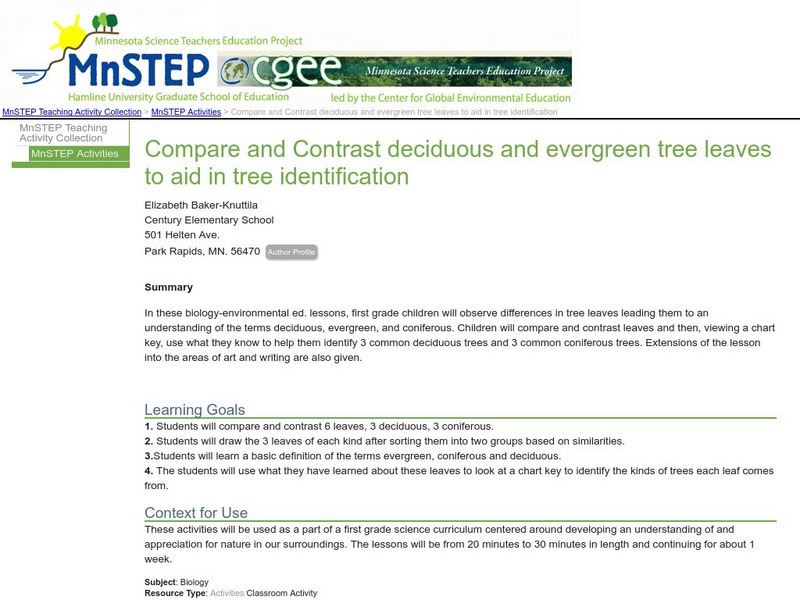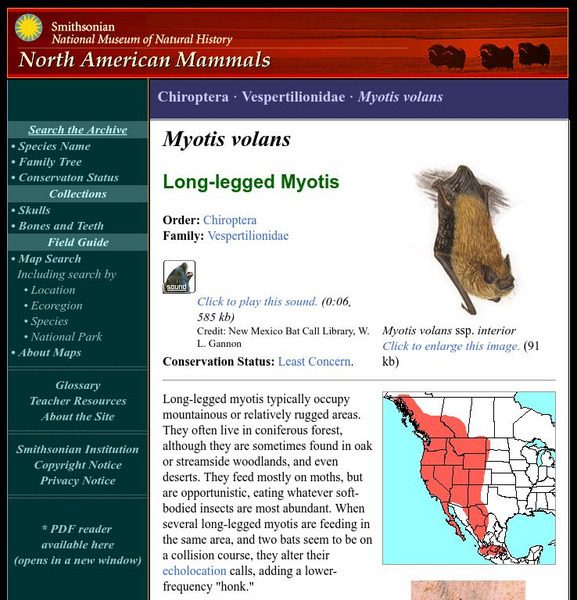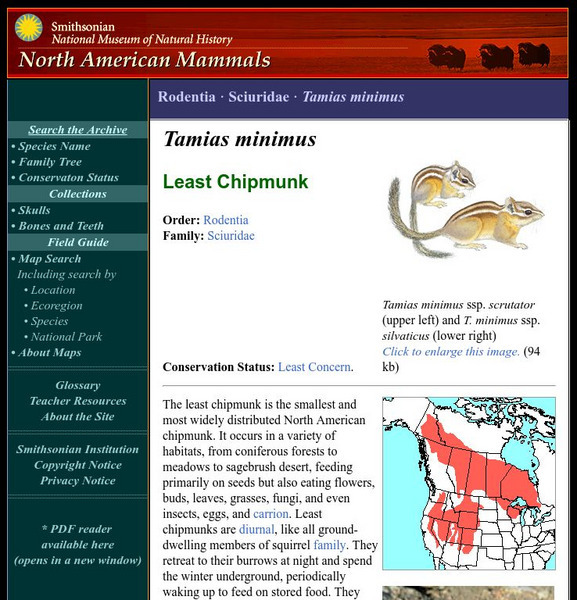Science Education Resource Center at Carleton College
Serc: Tree Identification: Compare and Contrast Deciduous and Evergreen Leaves
Learners observe differences in tree leaves leading them to an understanding of the terms deciduous, evergreen, and coniferous. Children will compare and contrast leaves and then, viewing a chart key, use what they know to help them...
Smithsonian Institution
National Museum of Natural History: American Mammals: Arctic Shrew
Arctic Shrews prefer grassy clearings and marshes within coniferous forests and are never very dense in population. Mortality is high early in life. Learn more about the Sorex arcticus, more commonly known as an Arctic Shrew, in this...
Smithsonian Institution
National Museum of Natural History: American Mammals: Cinereus Shrew
Mainly nocturnal and rarely seen, the Cinereus Shrew is nonetheless common and widespread below the timberline in northern deciduous and coniferous forests, in both wet and dry habitats. It is also known as the Masked Shrew and the...
Smithsonian Institution
National Museum of Natural History: American Mammals: Sonoma Tree Vole
The Sonoma Tree Vole nests so high in trees that finding one in a forest interior is quite difficult, and many records are from individuals that were living in trees that were cut down. A few coniferous tree species provide all of the...
Smithsonian Institution
National Museum of Natural History: American Mammals: White Footed Mouse
The White-footed Mouse has a very wide distribution. It is the most abundant rodent in mixed deciduous and coniferous forests in the eastern United States, and is probably equally abundant near farms. Learn more about the Peromyscus...
Smithsonian Institution
National Museum of Natural History: American Mammals: Southwestern Myotis
Southwestern myotis live in a variety of southwestern mountain habitats, from desert grasslands up into pine and mixed coniferous forest in the United States, and in desert and grassland in Mexico. These bats and two other myotis...
Smithsonian Institution
National Museum of Natural History: American Mammals: Long Legged Myotis
Long-legged myotis typically occupy mountainous or relatively rugged areas. They often live in coniferous forests, although they are sometimes found in oak or streamside woodlands, and even deserts. Learn more about the Myotis volans,...
Smithsonian Institution
National Museum of Natural History: American Mammals: Uinta Chipmunk
Uinta chipmunks are common in coniferous forests, especially at elevations higher than 1,800 m. They readily climb trees and shrubs to forage for seeds and often sleep in trees. Learn more about the Tamias umbrinus, more commonly known...
Smithsonian Institution
National Museum of Natural History: American Mammals: Least Chipmunk
The least chipmunk is the smallest and most widely distributed North American chipmunk. It occurs in a variety of habitats, from coniferous forests to meadows to sagebrush desert, feeding primarily on seeds but also eating flowers, buds,...
Smithsonian Institution
National Museum of Natural History: American Mammals: Gray Collared Chipmunk
Gray-collared chipmunks are found only in coniferous forests, at elevations of 1,950-3,440 m. They eat all kinds of vegetation and collect and store acorns underground or in hollow logs. Learn more about the Tamias cinereicollis, more...
Smithsonian Institution
National Museum of Natural History: American Mammals: Creeping Vole
Creeping Voles are found in moist coniferous forests at all stages of forest succession, from old growth to recent clear-cuts. In fact, population density is probably higher in recently cut areas where more sunlight reaches the ground...
Smithsonian Institution
National Museum of Natural History: American Mammals: Eastern Small Footed Myotis
The eastern small-footed myotis is one of the smallest North American bats. It has a limited range, occurring only in eastern deciduous and coniferous forests. Learn more about the Myotis leibii, more commonly known as an Eastern...
Wikimedia
Wikipedia: Taiga
Wikipedia, an open-source encyclopedia, offers a general overview of the taiga biome. A long list of taiga eco-regions can be found, each linking to its own encyclopedia entry.
Other
42 Explore: Trees and Forests
This is a site with links covering multiple areas of tree and plant study. Great illustrations and information.
Other
Geography Tutor: Vegetation
A list of questions about vegetation regions for your students to answer.
Ducksters
Ducksters: Science for Kids: Temperate Forest Biome
Kids learn about the temperate forest biome. Four distinct seasons and lots of trees.
Songs for Teaching
Songs for Teaching: Biomes
Use this site to see how many of the animals and plants that your students can remember from each biome after listening to this song.
Songs for Teaching
Songs for Teaching: Types of Biomes
Doug Eldon performs this great song which tells about the different biomes and their characteristics. Great way to begin your unit on the biomes.
Curated OER
Etc: Maps Etc: Vegetation of North America, 1916
A map from 1916 of North America, Central America, Greenland, and the Caribbean to Puerto Rico showing the general distribution of vegetation types in the region. The map is color-coded to show natural vegetation in areas of ice desert,...
Curated OER
Educational Technology Clearinghouse: Maps Etc: Vegetation Map of Europe, 1916
A map of Europe showing areas of different types of natural vegetation including tundra and alpine flora, coniferous forests, broadleaf forests and meadows, temperate grasslands, deserts, and oases.
Curated OER
Spruce Forest
Here you can find a great fact sheet on the taiga biome! Learn what the taiga is, where it's located, and the types of plants and animals that live there!
Other popular searches
- Coniferous Trees
- Coniferous Forests
- Coniferous Food Chain
- Coniferous Deciduous Trees
- Deciduous and Coniferous
- Pictures of Coniferous Trees
- Deciduous vs Coniferous
- Coniferous Plants
- Deciduous Coniferous
- Coniferous Forests Map
- Coniferous Forest Animals
- Geography Coniferous Forests

















